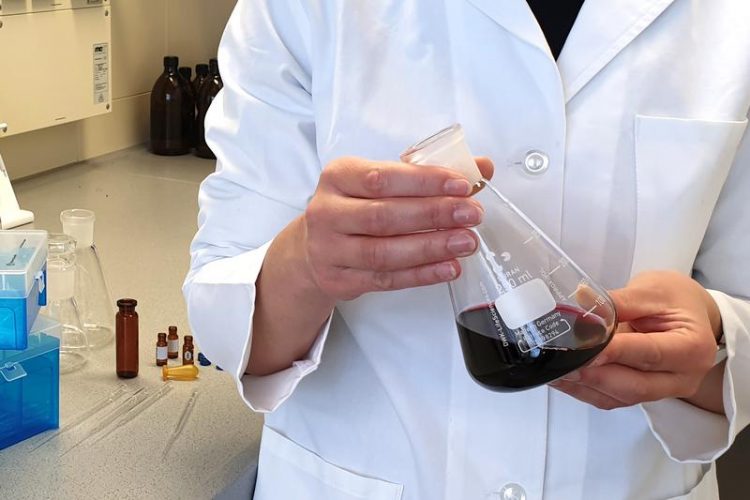Flavor research for consumer protection: benzaldehyde flavors can develop benzene under the influence of light

Starting point for the investigations was a pure cherry juice made from sour cherries in the laboratory. Gisela Olias / Leibniz-LSB
According to the German Federal Institute for Risk Assessment (Bundesinstitut für Risikobewertung, BfR), benzene is mainly absorbed by our bodies via the air we breathe. Non-smokers take in an average of 200 micrograms of benzene per day. Smokers take in around ten times as much.
But our food can also contain traces of this harmful substance and thus contribute to the exposure.
When the Stiftung Warentest examined soft drinks in 2013, they came across small quantities of benzene. One drink contained just under 4.6 micrograms of benzene per liter.
For comparison: In Germany, one liter of drinking water is allowed to contain only 1 microgram of the substance. At that time, experts at the Stiftung Warentest supposed that the odorant benzaldehyde was the cause of the benzene contaminations observed.
“As our research is specialized on odorants, we followed up on this supposition in the interest of consumer protection and at the suggestion of the German Association of the Flavor Industry (Deutscher Verband der Aromenindustrie, DVAI),” says lead author Stephanie Frank from the Leibniz-Institute for Food Systems Biology at the Technical University of Munich.
To do this, the team of scientists first established a reliable, highly sensitive quantitation method of benzene. Then, they carried out experiments with various model solutions which contained benzene-free benzaldehyde. The team also examined cherry juice produced under laboratory conditions, to which they also added the pure odorant.
Light is the crucial factor
“Our findings confirm the assumption of the Stiftung Warentest and also explain how the formation of benzene occurs. An important requirement in solving the problem in the long term,” reports food chemist Stephanie Frank.
As the study proves, the longer the odorant is exposed to light, the more benzaldehyde is converted into benzene. But the light intensity is also decisive. In contrast, the pH value, the oxygen content, the presence of metal ions or the temperature did not affect the benzene production in the model solutions.
To the surprise of the researchers, no benzene was formed in the cherry juice produced under laboratory conditions during light exposure. Frank reasons that it is possible that the dark red color of the drink acts as a light protection filter and prevents the formation of benzene. The benzene found in a few soft drinks sold commercially is probably the result of added cherry flavoring which has already been contaminated with benzene.
“This is why we must be sure to protect flavorings containing benzaldehyde from light, from when the substance is produced to when the product is sold, for example, by storing them in amber glass vials,” recommends Peter Schieberle, Professor for Food Chemistry at the Technical University of Munich.
Initiated by the research association Forschungskreis der Ernährungsindustrie e.V. (FEI), the research work in project AiF 18813 N was funded by the German Ministry of Economics and Energy based on a decision made by the German Bundestag as part of the program for promoting cooperative industrial research (IGF) via the German Federation of Industrial Research Associations “Otto von Guericke” e.V. (AiF).
Dr. Gisela Olias
Leibniz-Institute for Food Systems Biology
at the Technical University of Munich
Press & Public Relations
Lise-Meitner-Str. 34, 85354 Freising, Germany
Tel.: +49 8161 71 2980 – E-mail: g.olias.leibniz-lsb@tum.de
Web: https://www.leibniz-lsb.de/en
Dr. Stephanie Frank
Section I / work group Sensory Systems Chemistry
E-Mail: s.frank.leibniz-lsb@tum.de
S. Frank, A. Dunkel, P. Schieberle
Model studies on benzene formation from benzaldehyde
Eur Food Res Technol, 22. Feb. 2020 – DOI: 10.1007/s00217-020-03455-6.
https://link.springer.com/article/10.1007/s00217-020-03455-6
S. Frank, T. Hofmann, P. Schieberle
Quantitation of benzene in flavourings and liquid foods containing added cherry-type flavour by a careful work-up procedure followed by a stable isotope dilution assay
Eur Food Res and Technol, 245(8): 1605-1610 – DOI: 10.1007/s00217-019-03267-3.
https://link.springer.com/article/10.1007/s00217-019-03267-3
https://www.tum.de/nc/en/about-tum/news/press-releases/details/35952/ Press release on the TUM-website
https://www.leibniz-lsb.de/en Website of the Leibniz-Institute for Food Systems Biology
http://at the Technical University of Munich
https://www.fei-bonn.de/gefoerderte-projekte/projektdatenbank/aif-18813-n.projek… Website of the project (German)
Media Contact
All latest news from the category: Life Sciences and Chemistry
Articles and reports from the Life Sciences and chemistry area deal with applied and basic research into modern biology, chemistry and human medicine.
Valuable information can be found on a range of life sciences fields including bacteriology, biochemistry, bionics, bioinformatics, biophysics, biotechnology, genetics, geobotany, human biology, marine biology, microbiology, molecular biology, cellular biology, zoology, bioinorganic chemistry, microchemistry and environmental chemistry.
Newest articles

Properties of new materials for microchips
… can now be measured well. Reseachers of Delft University of Technology demonstrated measuring performance properties of ultrathin silicon membranes. Making ever smaller and more powerful chips requires new ultrathin…

Floating solar’s potential
… to support sustainable development by addressing climate, water, and energy goals holistically. A new study published this week in Nature Energy raises the potential for floating solar photovoltaics (FPV)…

Skyrmions move at record speeds
… a step towards the computing of the future. An international research team led by scientists from the CNRS1 has discovered that the magnetic nanobubbles2 known as skyrmions can be…





















